|
| |
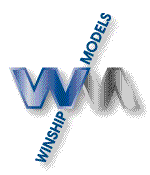
High quality laser cut control horns

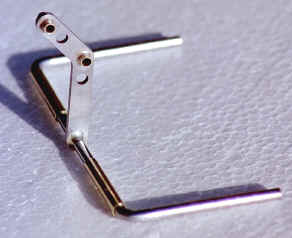 These
horns are laser cut to maintain accuracy that wouldn't be possible
other wise. The upright material is 1/16 inch aircraft steel brazed to 1/8
inch music wire. The wire retainer bushings are brass. The pushrod
bushings are 3/32 inch ID brass tubing brazed in place. The horn shown
above is suitable for the Impact by Paul Walker and the Blue Max by Kaz
Minato. Other designs could use this horn if the geometry works out. Click
here for the CAD dimensions.
The idea behind the shape of this horn is to keep the pushrod coming from
the bellcrank and the pushrod going to the elevator horn at 90 degrees in
relationship to the lever arm of this horn when the controls are in
neutral, thereby giving equal deflection in both directions. The elevator
horn has to be canted forward so that it is also at 90 degrees to the
pushrod. A good example of this geometry is on Ted Fancher's Trivial
Pursuit published in PAMPA magazine. Since the upright straight horns have
served the stunt flier so well why go to these horns? Since the arrival of
computer generated CAD programs designers have placed the geometry of our
control systems under scrutiny. They have discovered that when the numbers
are applied to conventional setups the deflection of the flaps and
elevators are not equal in both directions . Is the difference noticeable
when flying? It depends on the flier. Why stack tolerances when you don't
have to. The alignment of these horns are just as important as a
conventional horn. Attention to detail makes all the difference in the
world. The other reason these horns were not widely available was the fact
that they were costly to produce. These
horns are laser cut to maintain accuracy that wouldn't be possible
other wise. The upright material is 1/16 inch aircraft steel brazed to 1/8
inch music wire. The wire retainer bushings are brass. The pushrod
bushings are 3/32 inch ID brass tubing brazed in place. The horn shown
above is suitable for the Impact by Paul Walker and the Blue Max by Kaz
Minato. Other designs could use this horn if the geometry works out. Click
here for the CAD dimensions.
The idea behind the shape of this horn is to keep the pushrod coming from
the bellcrank and the pushrod going to the elevator horn at 90 degrees in
relationship to the lever arm of this horn when the controls are in
neutral, thereby giving equal deflection in both directions. The elevator
horn has to be canted forward so that it is also at 90 degrees to the
pushrod. A good example of this geometry is on Ted Fancher's Trivial
Pursuit published in PAMPA magazine. Since the upright straight horns have
served the stunt flier so well why go to these horns? Since the arrival of
computer generated CAD programs designers have placed the geometry of our
control systems under scrutiny. They have discovered that when the numbers
are applied to conventional setups the deflection of the flaps and
elevators are not equal in both directions . Is the difference noticeable
when flying? It depends on the flier. Why stack tolerances when you don't
have to. The alignment of these horns are just as important as a
conventional horn. Attention to detail makes all the difference in the
world. The other reason these horns were not widely available was the fact
that they were costly to produce. |
|
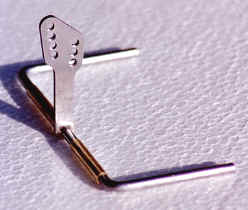 This
laser cut horn is patterned after the dimensions on Ted Fancher's Trivial
Pursuit plans published in the PAMPA
magazine. The horn looks a little different than the one on the plans
because extra holes were added and the extra outside material is removed
to save weight. The extra holes were added to give David Fitzgerald
greater adjustability if needed. The holes were tapped 4-40 for Rocket
City ball links. The upright arm is 1/16 inch aircraft steel, and the wire
is 1/8 music wire. The horn can also be constructed with 3/32 music wire
or 1/8 low carbon tweakable wire. If you do not want the holes tapped for
ball links, 3/32 inch ID brass tubing can be brazed in the holes of your
choice. The top two holes on the horn are the ones the Trivial Pursuit
plans specify. This horn would work on other aircraft as long as the
geometry works out. This
laser cut horn is patterned after the dimensions on Ted Fancher's Trivial
Pursuit plans published in the PAMPA
magazine. The horn looks a little different than the one on the plans
because extra holes were added and the extra outside material is removed
to save weight. The extra holes were added to give David Fitzgerald
greater adjustability if needed. The holes were tapped 4-40 for Rocket
City ball links. The upright arm is 1/16 inch aircraft steel, and the wire
is 1/8 music wire. The horn can also be constructed with 3/32 music wire
or 1/8 low carbon tweakable wire. If you do not want the holes tapped for
ball links, 3/32 inch ID brass tubing can be brazed in the holes of your
choice. The top two holes on the horn are the ones the Trivial Pursuit
plans specify. This horn would work on other aircraft as long as the
geometry works out.
|
|
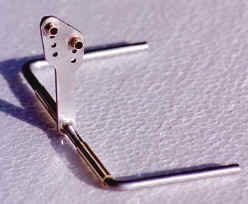 This
is an example of the horn above but with the exception of having the
bushings brazed in place. Refer to the laser dimension page hyperlink on
this page to see the dimensions of these horns. This
is an example of the horn above but with the exception of having the
bushings brazed in place. Refer to the laser dimension page hyperlink on
this page to see the dimensions of these horns.
|
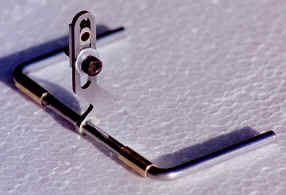 This
adjustable elevator horn is laser cut with with a dog leg to provide
clearance at the stabilizer trailing edge. By having a dog leg it is not
necessary to notch the trailing edge of the stabilizer to provide
clearance. The materials of this horn are the same as the other horns. The
steel slider block slides in a 1/8 inch slot for adjusting the control
ratio between the flaps and elevators and is held captive with a 4-40
socket head bolt. A bushing of 3/32 inch ID brass is installed in the
slider block. The adjustment range is between 1 1/8 inch on the high side
to approx. 3/4 inch on the low side. There is less adjustment on the high
side since more than 1 to 1 ratio is rarely, if ever used. By adjusting
more elevator throw into the setup you can increase the rate of turn. By
shortening the moment arm of this horn you increase the amount of elevator
deflection relative to the flaps. These horns are constructed with 3/32 or
1/8 inch music wire. This
adjustable elevator horn is laser cut with with a dog leg to provide
clearance at the stabilizer trailing edge. By having a dog leg it is not
necessary to notch the trailing edge of the stabilizer to provide
clearance. The materials of this horn are the same as the other horns. The
steel slider block slides in a 1/8 inch slot for adjusting the control
ratio between the flaps and elevators and is held captive with a 4-40
socket head bolt. A bushing of 3/32 inch ID brass is installed in the
slider block. The adjustment range is between 1 1/8 inch on the high side
to approx. 3/4 inch on the low side. There is less adjustment on the high
side since more than 1 to 1 ratio is rarely, if ever used. By adjusting
more elevator throw into the setup you can increase the rate of turn. By
shortening the moment arm of this horn you increase the amount of elevator
deflection relative to the flaps. These horns are constructed with 3/32 or
1/8 inch music wire. |
|